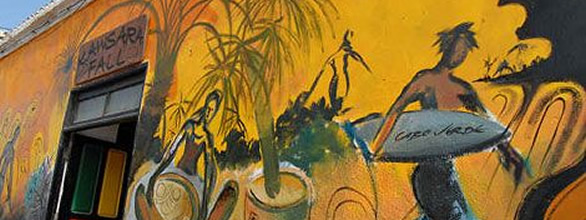Cabo
Verde
Art and culture |
| |
The Creole culture is characterized
by regular change and rash changes. It is rooted
in Portuguese, European and African traditions.
Especially distinctive are the African origins
in the music, rhythm and dances of the inhabitants.
The handicrafts, especially ceramics and weavings,
clearly indicate an African origin whereas the
crochet and embroidery are oriented towards Portuguese
patterns.
Especially worth mentioning
are the artistic co-operations that have been
developed on just about every island and which
currently cover the entire artistic range of Cape
Verde. The manufacturing of ceramics, pottery,
tapestry, wool blankets and baskets continue to
belong to a strong tradition that was hard-earned
by the rural population and serve as an expression
of their very own identity. |
| |
 |
| |
MMindelo on São Vicente
is not only the cradle of Cape Verdean painting,
but rather also the hub of the carnival, which
in respect to the colourful costumes and cheerful
friskiness hardly has anything to hide in comparison
to Rio de Janeiro or Bahià, even if on
a much smaller scale.
The music is a regular component and an unmistakeable
expression of Cape Verdean customs. Music is a
remedy for the soul. It belongs to this country
like the wind, the sea and the brusque mountains.
With Cesaria Evora, the voice of Cape Verde, the
musical form of the Morna has found a dignified
representative. In the course of the years, she
has made her homeland known all around the world.
In addition to the "Morna", which is
regularly compared to the melancholic sad sounds
of the Portuguese Fado, the musical direction
of "Coladeira" has taken the forefront
with its cheerfully inspired dance songs that
are accompanied by guitars, mandolins and violins. |
| |
|
|
 |
|